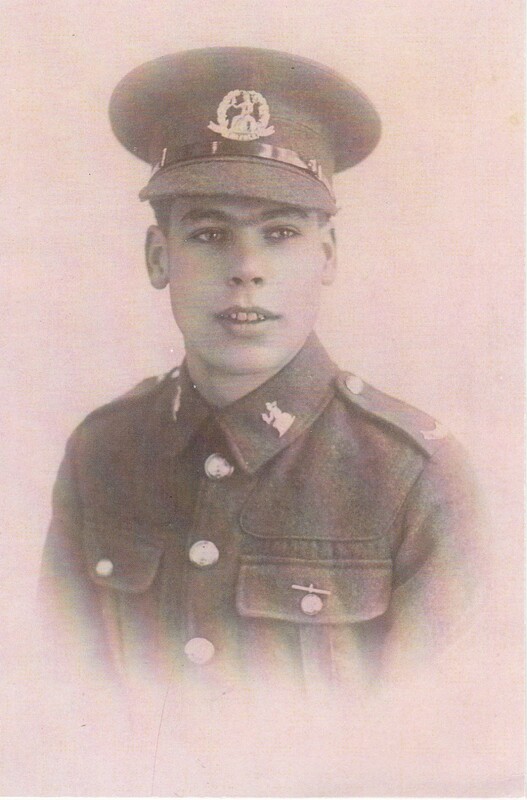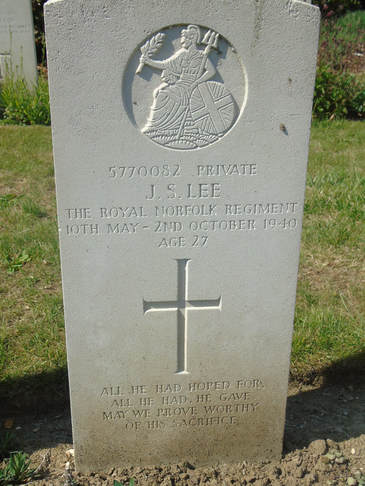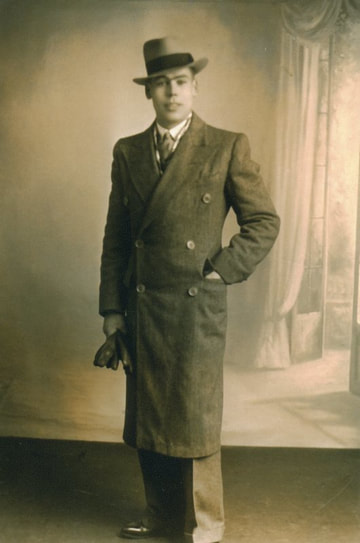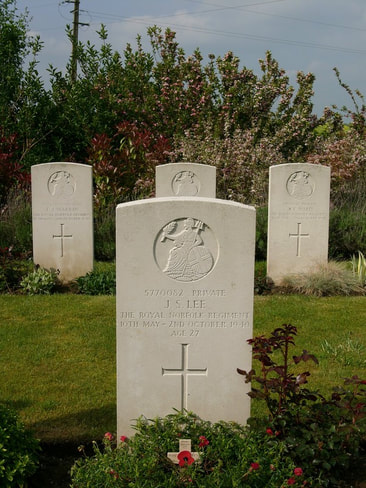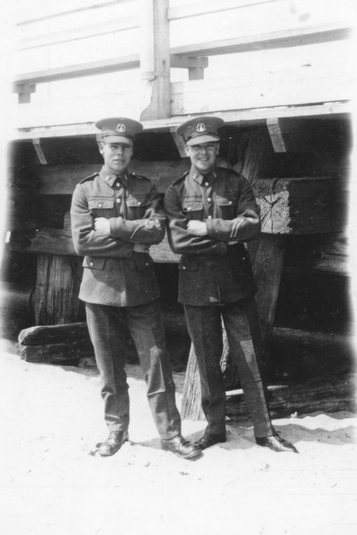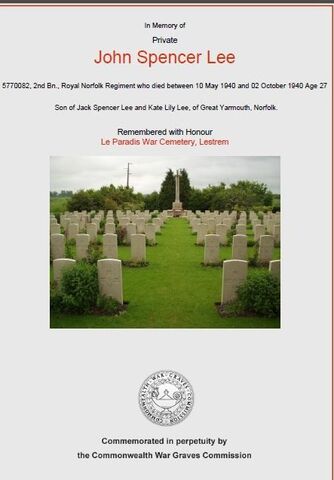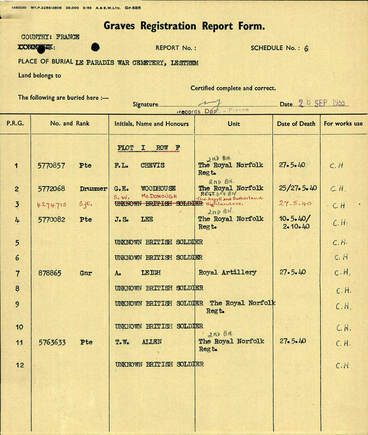Private John Spencer Frederick Lee
Private 5770082 John Spencer Frederick Lee:
Died May 10th - October 2nd, 1940
Aged 27
Inscription on his gravestone reads:
ALL HE HAD HOPED FOR
ALL HE HAD, HE GAVE
MAY WE BE WORTHY
OF HIS SACRIFICE.
John Lee was born on 20th September, 1912, in the St Nicholas Parish of Great Yarmouth. He was the eldest son of Jack Spencer Lee and Kate Lee (nee Purt). He had two brothers, Fredrick Arthur and Thomas George and a sister Kate Lilly. He also had a stepbrother Ernie who was lost at sea in 1940, aged 19.
When his mother died on 8th November, 1919, Fred moved to live with his aunt in Ilford, London. Tom and sister Kate moved to live with their Aunt Rose in Great Yarmouth but John was placed in a children’s home. He was very unhappy there and would often run away but was always returned by the authorities. This was part of the reason he joined the Army at such a young age.
On 17th October, 1929, he enlisted in the Fourth Battalion, the Royal Norfolk Regiment Territorial Army for four years. On 11th February, 1931, he enlisted for seven years in the regular army and a further five years reserve service in the 2nd Battalion of the Royal Norfolk Regiment in Norwich with the regimental number 5770082.
On 30th March, 1937, he was posted to Gibralter with numerous other soldiers who would be caught up in the fighting at Le Paradis. He returned to the UK on 25th November, 1937, and, on 9th December, was assigned to the General Training Centre at Waddon.
John was in the army reserve from 15th May, 1938, until 14th June, 1939, before rejoining the colours on 15th June. On 20th September, 1939, he was posted to France. He enjoyed 10 days' leave in the UK from 13th March, 1940, before returning to France.
On 19th June, 1940, he was reported missing in action and on 20th June it was announced that he had been killed on active service between 10th May and 20th June. He was initially buried at Hinges Cemetery and then Le Paradis.
Our photographs of John Lee include a studio shot taken for his 21st birthday in 1933. John stayed with his sister Kate whenever he was home on leave. Another photograph is of John (on the left) with one of his mates and the one at the top of the page is John Lee pictured shortly after joining up. These photographs have been sent to us and are used with the permission of the Lee family.
John has also been identified under the battalion photographs which can be viewed under the section on the Royal Norfolks which can be accessed by clicking here.
In the photograph entitled "The 2nd Battalion of the Royal Norfolk Regiment taken in 1939" John is on the far back row third from the left. There is a soldier in front of him slightly to the right, displaying corporal stripes.
In the photograph entitled "Members of the Royal Norfolk Regiment at Charlton Park, Malmesbury in Wiltshire in 1934" John is on the far right. The photograph was sent to Dennis O'Callaghan by the Lee family and is used with their kind permission. The family have marked an X above his head for ease of identification.
The mystery as to why John was initially buried at Hinges before being re-interred at Le Paradis has not been solved. The fighting was intense around this area between 24th and 27th May, 1940, with communications being lost or intermittent between A, B, C and D Company of the 2nd Battalion, the Royal Norfolk Regiment.
John's nephew agrees that the Norfolk's were defending La Bassee Canal and were split up along it to Le Paradis where the last stand took place and there was much confusion. He goes on to state that John could have been buried by the village other than at Le Paradis in a temporary grave because there was initially not enough space at Le Paradis. John's nephew's observation goes to the photograph of the village people tending the first burial place at Le Paradis where there does not appear to be many graves and certainly not 97. There could also have been a mistake made with his identity and he did make it to Le Paradis to join the final battle.
We would welcome any assistance or comments on this issue.
Died May 10th - October 2nd, 1940
Aged 27
Inscription on his gravestone reads:
ALL HE HAD HOPED FOR
ALL HE HAD, HE GAVE
MAY WE BE WORTHY
OF HIS SACRIFICE.
John Lee was born on 20th September, 1912, in the St Nicholas Parish of Great Yarmouth. He was the eldest son of Jack Spencer Lee and Kate Lee (nee Purt). He had two brothers, Fredrick Arthur and Thomas George and a sister Kate Lilly. He also had a stepbrother Ernie who was lost at sea in 1940, aged 19.
When his mother died on 8th November, 1919, Fred moved to live with his aunt in Ilford, London. Tom and sister Kate moved to live with their Aunt Rose in Great Yarmouth but John was placed in a children’s home. He was very unhappy there and would often run away but was always returned by the authorities. This was part of the reason he joined the Army at such a young age.
On 17th October, 1929, he enlisted in the Fourth Battalion, the Royal Norfolk Regiment Territorial Army for four years. On 11th February, 1931, he enlisted for seven years in the regular army and a further five years reserve service in the 2nd Battalion of the Royal Norfolk Regiment in Norwich with the regimental number 5770082.
On 30th March, 1937, he was posted to Gibralter with numerous other soldiers who would be caught up in the fighting at Le Paradis. He returned to the UK on 25th November, 1937, and, on 9th December, was assigned to the General Training Centre at Waddon.
John was in the army reserve from 15th May, 1938, until 14th June, 1939, before rejoining the colours on 15th June. On 20th September, 1939, he was posted to France. He enjoyed 10 days' leave in the UK from 13th March, 1940, before returning to France.
On 19th June, 1940, he was reported missing in action and on 20th June it was announced that he had been killed on active service between 10th May and 20th June. He was initially buried at Hinges Cemetery and then Le Paradis.
Our photographs of John Lee include a studio shot taken for his 21st birthday in 1933. John stayed with his sister Kate whenever he was home on leave. Another photograph is of John (on the left) with one of his mates and the one at the top of the page is John Lee pictured shortly after joining up. These photographs have been sent to us and are used with the permission of the Lee family.
John has also been identified under the battalion photographs which can be viewed under the section on the Royal Norfolks which can be accessed by clicking here.
In the photograph entitled "The 2nd Battalion of the Royal Norfolk Regiment taken in 1939" John is on the far back row third from the left. There is a soldier in front of him slightly to the right, displaying corporal stripes.
In the photograph entitled "Members of the Royal Norfolk Regiment at Charlton Park, Malmesbury in Wiltshire in 1934" John is on the far right. The photograph was sent to Dennis O'Callaghan by the Lee family and is used with their kind permission. The family have marked an X above his head for ease of identification.
The mystery as to why John was initially buried at Hinges before being re-interred at Le Paradis has not been solved. The fighting was intense around this area between 24th and 27th May, 1940, with communications being lost or intermittent between A, B, C and D Company of the 2nd Battalion, the Royal Norfolk Regiment.
John's nephew agrees that the Norfolk's were defending La Bassee Canal and were split up along it to Le Paradis where the last stand took place and there was much confusion. He goes on to state that John could have been buried by the village other than at Le Paradis in a temporary grave because there was initially not enough space at Le Paradis. John's nephew's observation goes to the photograph of the village people tending the first burial place at Le Paradis where there does not appear to be many graves and certainly not 97. There could also have been a mistake made with his identity and he did make it to Le Paradis to join the final battle.
We would welcome any assistance or comments on this issue.
